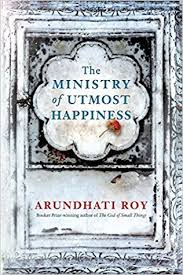I am cross-posting my review of Arundhati Roy’s latest novel. This review originally appeared on The South Asian Idea in June 2017.

Ever since The God of Small Things was published to great acclaim in 1997, Arundhati Roy’s fans have been eagerly awaiting her next novel. It was a long wait—two decades—as Roy transitioned from being a novelist to being an activist and a non-fiction writer. Now, the wait has finally ended with the publication of The Ministry of Utmost Happiness.
The novel focuses on several characters, most of whom are outcasts from the new rising India. They include a hijra named Anjum, a Kashmiri separatist (or freedom fighter) named Musa and Tilottama, the Malayali woman who loves him. Over the course of the novel, these disparate characters encounter one another and their stories intersect, sometimes in surprising ways.
Much of the novel is set in the Kashmir Valley during the 1990s—at the height of the insurgency against the Indian state—viewed by many Kashmiris as an occupying force. Musa’s wife and daughter are killed in crossfire between the Indian Army and Kashmiri militants. Tilo herself is harshly interrogated by the Indian Army and is only let go because of her connections to an old college friend, who is high up in the Intelligence Bureau. In this section of the novel, Roy evocatively describes the brutality of life in Kashmir and the impact it has on those on both sides of the ideological struggle.
Those who have followed Roy’s non-fiction will find many resonances in this novel. Asides from the Kashmir conflict, the plot touches on rising Hindutva, the Maoist struggle in the forests of central India, and Dalit assertion against upper-caste violence. One consequence of such a large canvas is a certain fracturing of the narrative. For example, when the narrative moves to Kashmir, Anjum has to be abandoned in Delhi. Although Roy convincingly brings the characters together at the end, there is a sense of disconnect while reading the story.
At times, the overt political focus detracts from the literary quality of the novel. Roy seems less interested in portraying her characters’ inner feelings than in using them to develop a polemic against what she sees as the dark side of contemporary India—increasing religious intolerance, casteism, and human rights violations.
There is no inherent reason that such an intense political focus should detract from literary accomplishment. Salman Rushdie’s Midnight’s Children and Rohinton Mistry’s A Fine Balance deal powerfully with subjects such as Partition and Indira Gandhi’s Emergency. Roy’s own The God of Small Things is equally political, focusing on inter-religious and inter-caste relationships as well as untouchability. However, in these novels the story is primary and the politics emerges organically from the plot. The characters are fully developed and one feels the authors are invested in their lives. The Ministry of Utmost Happiness, in contrast, is much more polemical. The plot seems to be an excuse for Roy to express her ideas on the subjects that have consumed her for years. An ambitious and honest portrayal of the heart of darkness at the center of contemporary India, the novel is likely to underwhelm many readers who are not Ms. Roy’s devotees.
To read more of my book reviews, you can visit https://kabiraltaf.wordpress.com/